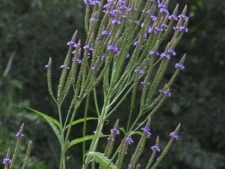
This native, erect perennial usually grows 2-4 feet tall, sometimes reaching 6 feet. Opposite, coarsely toothed, smooth, short-stalked leaves are 2-6 inches long (B,C). The larger leaves may have two small, toothed lobes at the base. From one to many erect flower spikes 2-6 inches long with tapered, pointed tips occur in loose, branching clusters at the top of the stem. Spikes consist of blue to purple, sometimes paler, tubular 1/4 inch flowers with 5 spreading lobes (A). Flowering begins at the base and proceeds to the tip of the spike.
Grows in lowland prairies and other open, moist sites, flowering from June through September. In Fontenelle Forest, Blue Vervain is rare along the Missouri River at the end of Child’s Hollow and uncommon in moister portions of the Floodplain Prairie planting. At Neale Woods, it is common in the OPPD wetland mitigation planting in Jonas Valley.
Preference for moist sites, stalked, smooth leaves and tapered, pointed tips of the flower spikes separate this plant from similar Hoary Vervain (Verbena stricta), a plant of drier upland sites, which has flower spikes with rounded tips and leaves covered with dense, soft hairs.
The Teton Dakota boiled the leaves using the tea as a remedy for stomach pains. Omahas used the leaves to make a tea-like beverage.
Other common names include False or American Vervain and Blue Verbena.
The content of NatureSearch is provided by dedicated volunteer Naturalists of Fontenelle Forest who strive to provide the most accurate information available. Contributors of the images retain their copyrights. The point of contact for this page is: Neal Ratzlaff.


